Tree View: Users Right-Click Menu
Right-click on Users in the tree view. The following menu is displayed.
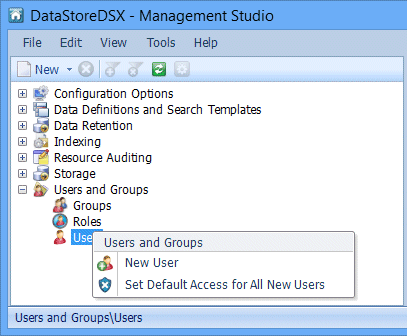
New User
When New User is selected, the User Editor window is displayed.
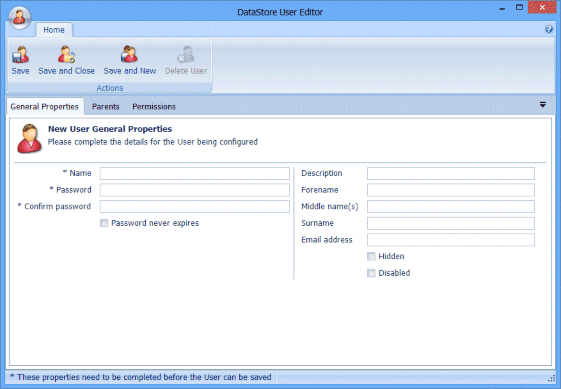
General Properties
The New User General Properties are described in Table 151.
Table 151. Terminology: New User General Properties
|
Term |
Meaning |
||
|---|---|---|---|
|
Name |
Create a login name for the User. This is the user name the person will use to log in to the DataStore®DSX applications. This field is mandatory when creating a new User. Maximum 255 characters. |
||
|
Password |
Create a password for the User. Password policies (including password length) are defined by your DataStore®DSX administrator. When Users attempt to change their own passwords and enter new passwords which do not adhere to the configured password policy, the following message is displayed: The User cannot be saved as the password is invalid. Please ensure the password is within the required size and doesn’t contain any invalid characters. For more information, please consult your help. |
||
|
Confirm password |
Re-type the password to ensure you have entered it correctly. If the password entered in the Confirm Password box does not match the password entered in the Password box, the following message is displayed.
Click OK and re-type the Confirm Password so it matches the Password. |
||
|
Password never expires |
When selected, the User’s password never expires. When cleared, the User’s password expires after the number of days set by the DataStoreDSX administrator for the Pass- wordExpiryDays. See PasswordExpiryDays in “Password Requirements” for more information. |
||
|
Description |
If required, enter a description of the User. When entered, this becomes part of the Display Name used on the Users and Groups page and at the bottom right of the window. Maximum 255 characters. |
||
|
Forename |
If required, enter the first name of the User. When entered, this becomes part of the Display Name used on the Users and Groups page and at the bottom right of the window. Maximum 80 characters. |
||
|
Middle name(s) |
If required, enter the middle name of the User. When entered, this becomes part of the Display Name used on the Users and Groups page and at the bottom right of the window. Maximum 80 characters. |
||
|
Surname |
If required, enter the last name of the User. When entered, this becomes part of the Display Name used on the Users and Groups page and at the bottom right of the window. Maximum 80 characters. |
||
|
Email address |
If required, enter the email address of the User. |
||
|
Hidden |
When selected, the User’s icon is dimmed when viewed by other Users with the correct access permissions. This feature will be utilised by future enhancements. When cleared, the User can be viewed normally. |
||
|
Disabled |
When selected, the User’s account is unavailable. If the User whose account has been disabled is currently logged in, they will be unable to use the applications. If they are logged out when their account is disabled, they will be unable to log in again (unless their account is Enabled again by clearing the Disabled box). |
Parents
Selecting the Parents tab enables you to add the current User to Groups or Roles.
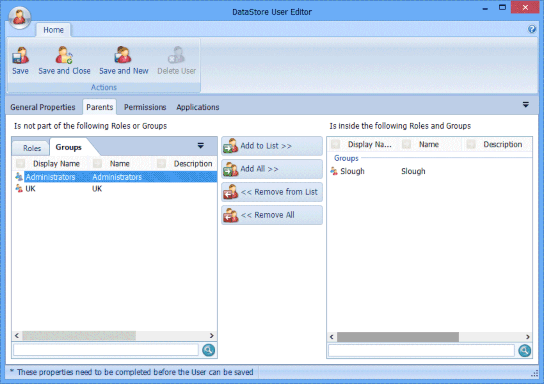
Select one or more Groups and/or Roles from the Roles and Groups tabs and click Add to List >>.
The selected Groups and Roles are displayed in the Is inside the following Role and Groups pane and are now parents of the current User (that is, the current User is a member of the Groups and Roles displayed in the right-hand pane).
The members of a Group or Role inherit Permissions and Access Control Lists set for that Group or Role according to the inheritance calculations described earlier. See “Permissions Inheritance” and “Access Control Lists Inheritance”.
An item can be removed from the Is inside the following Roles and Groups list by selecting the item and clicking the << Remove from List button.
Note: It is not possible to add a Group whose Source is Active Directory to the list of Parents of a User.
Permissions
Selecting the Permissions tab enables you to configure the functionality to which the User is given access.
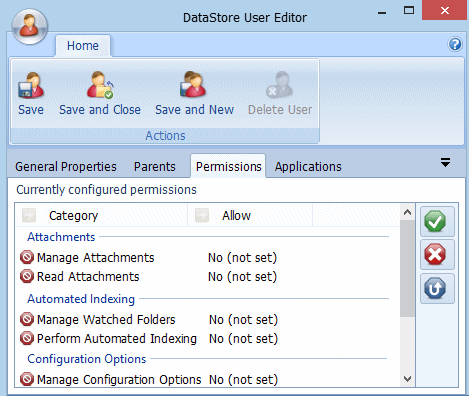
 Select a category you want to configure, then click the Allow button to allow access to the selected functionality.
Select a category you want to configure, then click the Allow button to allow access to the selected functionality.
 Deny button to prevent access to the selected functionality.
Deny button to prevent access to the selected functionality.
 Inherit button to return the setting to the default.
Inherit button to return the setting to the default.
The Permissions categories are described in Table 152.
Table 152. Terminology: User Permissions
|
Term |
Name |
||
|---|---|---|---|
|
Attachments |
|||
|
Manage Attachments |
Controls whether members of the current User have permission to create, edit and delete attached annotations in Searching Client – see “Attachments Toolbar”. |
||
|
Read Attachments |
Controls whether the members of the current User have permission to read attached annotations that have been attached to a document in Searching Client– see “Attachments Toolbar”. |
||
|
Automated Indexing |
|||
|
Manage Watched Folders |
Controls whether the members of the current User have access to the Watched Folders Indexing functionality in Management Studio. |
||
|
Perform Automated Indexing |
Controls whether the current User has access to the Automated Indexing functionality in Management Studio. |
||
|
Configuration Options |
|||
|
Manage Configuration Options |
Controls whether the members of the current User have access to the Configuration Options functionality in Management Studio. (Set to Allow by default.) When set to Allow, the members will be allowed to access and set up the various options under Configuration Options in the left-hand side tree view. When set to Deny, the members will not be shown the Configuration Options heading in the tree view and therefore will not be allowed to access and set up the various options. |
||
|
Data Definitions and Search Templates |
|||
|
Manage Custom Field types |
Controls whether the members of the current User have permission to create, edit and delete Custom Fields Types. When set to Allow, the members of the current Role have access to the Custom Field Types functionality in Management Studio. |
||
|
Manage Data Definitions |
Controls whether the members of the current User have permission to create, edit and delete Data Definitions. When set to Allow, the members of the current Role have access to the Data Definitions functionality in Management Studio. |
||
|
Manage Index Assistants |
Controls whether the members of the current User can configure Server-side Index Assistants. This includes running any Index Assistants via Automated Indexing from watched folders. |
||
|
Manage Search Assistants |
Controls whether the members of the current User can configure Search Assistants. |
||
|
Manage Search Templates |
Controls whether the members of the current User have permission to create, edit and delete Search Templates. When set to Allow, the members of the current Role have access to the Search Templates functionality in Management Studio. |
||
|
Manage Style Sheets |
Controls whether the members of the current User have permission to create, edit and delete Style Sheets. When set to Allow, the members of the current Role have access to the Style Sheets functionality in Management Studio. |
||
|
Field Value Modification |
|||
|
Modify Field Values |
Controls whether the members of the current User have permission to change Index Field Values in Searching Client. See “Modify Index Values” for more information. |
||
|
Full Text Indexing |
|||
|
Manage Full Text Indexing |
Controls whether the members of the current User have permission to manage Full Text Indexing. See “Content Full Text Searchable” for the list of steps the Role members will be granted permission to manage, before Full Text Searching can be initiated in Searching Client. |
||
|
Read Full Text Indexing |
Controls whether the members of the current User have permission to access and view Key Word, Phrase and Sentence searching, which will further enhance the searching performance in Searching Client. |
||
|
Resource Auditing |
|||
|
Manage Auditing |
Controls whether the members of the current User have access to the Resource Auditing functionality in Management Studio. |
||
|
Retention Policies |
|||
|
Manage Retention Policies |
Controls whether the current User has permission to create, edit and delete Retention Policies. When set to Allow, the User has access to the Data Retention functionality in Management Studio. |
||
|
Read Retention Policy |
Controls whether members of the current User have permission to view Retention Policies. |
||
|
Reports |
|||
|
Manage Reports |
Controls whether the User has permission to Manage Reports as described in “Reporting Services”. |
||
|
Read Reports |
Controls whether the User has permission to Read Reports as described in “Reporting Services”. |
||
|
Storage |
|||
|
Manage Storage |
Controls whether the current User has permission to create, edit and delete Storage Devices and Depots in DSX and delete Data Items in DSX and Workflow. When set to Allow, the current User has access to the Storage functionality in Management Studio.
|
||
|
View Storage |
Controls whether the current User has permission to view Storage Devices and Depots.
|
||
|
Users and Groups |
|||
|
Manage Application Licences |
Controls whether the current User has permission to change the Application Permissions of other users. See “Applications” for more information on Application permissions. |
||
|
Manage Users & Groups |
Controls whether the current User has permission to create, edit and delete Users, Groups and Roles. When set to Allow, the current User has access to the Users and Groups functionality in Management Studio. |
||
|
Modify Own Password |
Controls whether the current User has permission to change their own password.
|
||
|
Data Export |
|||
|
Export From Applications |
Controls whether the current User has permission to Export search results, Email search results and Copy search results. When set to Allow, the current User has access to the appropriate buttons in Searching Client. See “Export Search Results”, “Quick Export to Excel”, “Email Search Results” and “Copy Search Results” for a description of the button. |
||
|
Print From Applications |
Controls whether the members of the current User have permission to Print search results. When set to Allow, the members of the current User have access to the appropriate button in Searching Client. See “Copy Search Results” for a description of the button. |
||
|
Copy Text Selections |
Controls whether the members of the current User have permission to select Copy All or Copy Selection from the right- click menu in Searching Client. See “Right-Click Menu”. |
||
The Permissions configured as Inherit for a User might be superseded by the Permissions configured for Groups and Roles to which the User belongs. See “Permissions Inheritance”for more information.
Applications
Selecting the Applications tab enables you to configure the applications to which the User is given access.
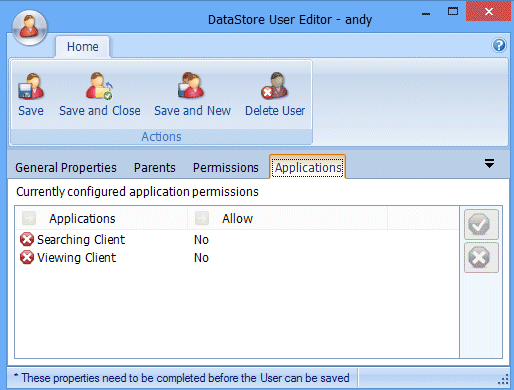
 Select the application you want to configure, then click the Allow button to allow access to the selected application.
Select the application you want to configure, then click the Allow button to allow access to the selected application.
 Select the Deny button to prevent access to the selected application:
Select the Deny button to prevent access to the selected application:
The Applications are described in Table 153.
Table 153. Terminology: User Applications
|
Term |
Name |
|---|---|
|
Searching Client |
Allow or Deny access to the Searching Client application. |
|
Viewing Client |
Allow or Deny access to the Viewing Client application. |
Save and Close Button
Click the Save and Close button to save the current User and close the User Editor window.
Save and New Button
Click the Save and New button to save the current User and create a new User in the User Editor window.
Delete User Button
Caution: Before deleting a User, ensure there is no object (User, Group, Role or Data Definition) that can only be managed by this User, as once deleted, these objects will no longer be able to be modified and may even be completely inaccessible (and in the case of a Data Definition, this would also apply to all the data that has been archived against it).
Click the Delete User button to delete the current User. When the User has been successfully deleted you are prompted whether you want to then create a new User. If you click Yes, a new User is created in the User Editor window. If you click No, the User Editor window is closed.
Note: It is not possible to delete a User whose Source is Active Directory. Only Users created within Management Studio (Source: Manual) can be deleted.
Set Default Access for all new Users
When Set Default Access For All New Users is selected, the Access Control Security Configuration window is displayed.
This window enables you to set the Users, Groups and Roles which will be able to access any new Users which are created.
A User’s Access Control settings can be changed (by a User who has been given access to the User) at any time. See “Control Access to this Role” for details on how to select the Users, Groups and Roles which will, by default, have access to new Users.


